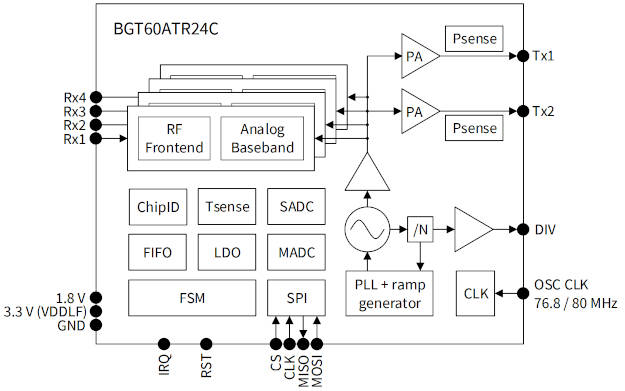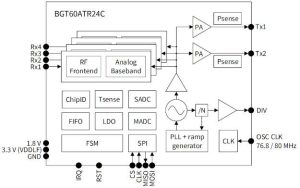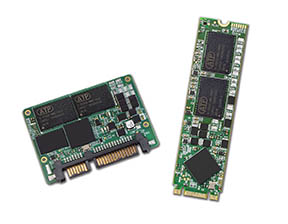
“In-cabin monitoring systems detect micro-movements as well as vital signs of left-behind infants and animals and sound the alarm,” according to the company. “The radar sensor enables additional functions such as seat belt reminder and applications such as gesture sensing.”
BGT60ATR24C, as it will be known, is intended to work with external antennas (there is no in-package antenna) and implements a 4GHz bandwidth FMCW (frequency-modulated continuous-wave) radar with two transmit and four receive channels.

Each receiver path includes baseband filtering, a VGA (variable gain amplifier) and an ADC.
The digitised IF output is stored in a FIFO from which data is transferred to an external host MCU or MPU where the radar processing stack needs to reside – transfer is via an SPI bus.
The sensor is qualified for automotive applications according to AEC-Q100/101, and comes in a 6 x 6mm BGA package.
There is a kit that the company recommends for evaluation and algorithm development.
Called ‘Demo BGT60ATR24C P2S Board’, it consists of two parts and a support package:
- Base board: ‘Kit_Aurix_2G_Radar’, with a 300MHz TC356TA MCU for radar baseband processing. Towards for ASIL-D safety level qualification, this includes two checker cores.
- Add-on shield: ‘Shield_ATR24ES_01’, which is BGT60ATR24C-based and has a 3 x 4 virtual antenna array
- Support package: ‘Radar BGT60ATR24C P2S’ with GUI, software, firmware, application notes, datasheets, communication library, schematics and gerber files.







